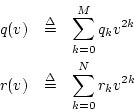 |
(L.5) |
A large class of well posed PDEs is given by [43]
To show Eq. (L.5) is well posed [43], we must show that the roots of the characteristic polynomial equation have negative real parts, i.e., that they correspond to decaying exponentials instead of growing exponentials. To we insert the general eigensolution

Let's now set ![]() , where
, where
![]() is radian spatial
frequency (called the ``wave number'' in acoustics) and of course
is radian spatial
frequency (called the ``wave number'' in acoustics) and of course
![]() , thereby converting the implicit spatial Laplace
transform to a spatial Fourier transform. Since there are only even
powers of the spatial Laplace transform variable
, thereby converting the implicit spatial Laplace
transform to a spatial Fourier transform. Since there are only even
powers of the spatial Laplace transform variable ![]() , the polynomials
, the polynomials
![]() and
and ![]() are real. Therefore, the roots of the
characteristic polynomial equation (the natural frequencies of the
time response of the system), are given by
are real. Therefore, the roots of the
characteristic polynomial equation (the natural frequencies of the
time response of the system), are given by